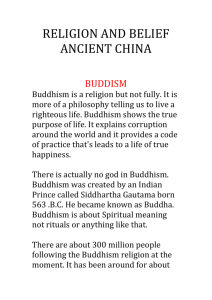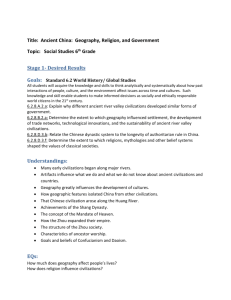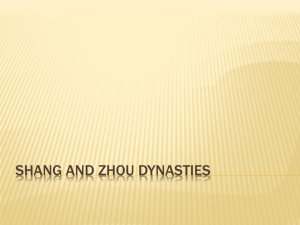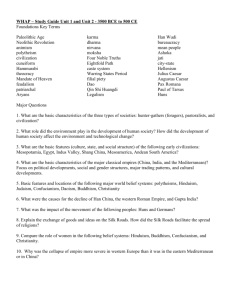China: Intro to Later Zhou
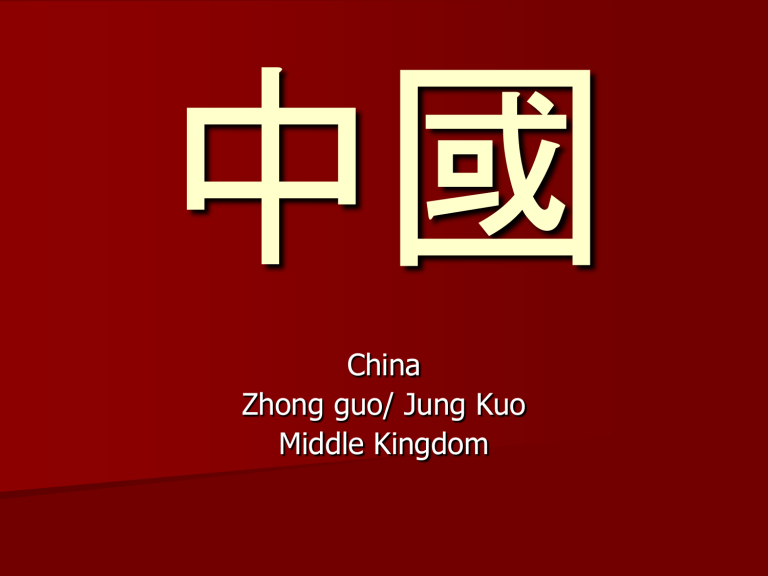
中國
China
Zhong guo/ Jung Kuo
Middle Kingdom
Middle Kingdom
Center of the Known Universe
Economic Center
Geographic Center
Cultural Center
Scientific Center
Political Center
Demography
Population:
1,319,175,332
Estimate Jan. 2007
Religion / Philosophy:
Secular Communism
Confucianism
Buddhism
Daoism
Islam
Christianity
Major Historical Achievements
Great Wall
Civil Service
Bureaucracy
Political theory and practice
Theories of War and Peace
Early Written Language
Rich Literature
Philosophy / Religion
Daoism
Buddhism
Science and Technology
Bronze
Steele
Printing
Fireworks
Rice Agriculture
Noodles
ETC…..
Language
Pictographs
Idiographs
Monosyllabic
Written:
– Concise
– Universal
Spoken:
– Prolix
– Tonal
– Dialects
Chronological History
History VS Archeology
Shang Dynasty:
1523-1027 BC (BCE)
Writing system (1300 BC)
Oracle bones
Centralized government
1027-221 BC
Zhou Dynasty
Early Zhou: 1027-771 BC
Overthrow of the Shang
What to do with the Shang Nobility???
-- the answer depends on culture…
Early Zhou:
Mandate of Heaven
天命
(Tienming)
Tien rules fates of dynasties
Tien willed fall of Shang
Tien willed success of Zhou
Floods, famines, natural disasters, and political upheaval demonstrate displeasure
Tien’s
Justify revolt and revolution
Po:
Ancient Chinese Concept of the
Human Soul
Animal Soul (physical body)
Dies, returns to earth
Should be respected
Hun:
Spiritual Soul (spirit)
Lives on in the location of its life
Happy guardian spirit
Unhappy malicious ghost
Fate depends on memory and care by descendents
Ancient Chinese Concept of the
Human Soul
Consequences:
Reverence for ancestors
Ceremonies
Ancestor Veneration (worship?)
Elaborate genealogical records
Gentry tied to land
Ancient Chinese Concept of the
Human Soul
Consequences continued:
Little emigration
Little voluntary migration
Need to produce a son
Tempers genocide after revolution
Zhou do not destroy Shang nobility so they won’t be haunted by their ancestors
Social Science and Religion
Rules for social science analysis of religion:
Suspend judgment
Try to understand what others believe
Try to see HOW those beliefs motivate behaviors
Don’t ask if it is ‘true’ or ‘logical.’ Social science can’t assess that.
Avoid judgmental language: primitive, superstitious, stupid …
Understanding others’ beliefs need not threaten your own.
Ancient Chinese Religious Beliefs and Practices
Animism:
All objects have spirits
Spirits have human characteristics
From Pocahontas: “But I know every rock and tree and creature has a life, has a spirit, has a name.”
Ancient Chinese Religious Beliefs and Practices
Shamanism:
Animistic religion with a special mediator or
Shaman to help make peace between the human world and the spirit world.
Medicine man
Mystic
Witch doctor
Xi Wang Mu: Queen Mother of the West
Early Zhou
Tien as Patron Diety
Mandate of Heaven as Justification
No Priestly Class
King intermediates between gods (esp.
Tien ) and human world
If the gods are unhappy, it is the king’s fault
Transition to Later Zhou
(Eastern Zhou) 771-221 BC
Decay and corruption at the center
King’s Favorite loved the Signal Fires
The King who cried wolf
771 BC: transfer capital east to
Luoyang
Later Zhou
Political Structure loosened
Provinces have great autonomy
Central Government weaker
– More flexibility for
Innovation
Creativity
New philosophy
Later Zhou and Philosophy
Confucianism
– Kung Fu Zi (Confucius) 551-479 BC
Taoism ( Daoism )
– Laozi ( Lao Tzu ) 500s BC
Art of War
– Sunzi ( Sun Tsu )
Philosophy of Love and Brotherhood
– Mozi ( Mo Tzu ) 470-391 BC
Legalism, 300s BC
– Han Fei Zi, 200s BC
Mozi
Han Fei Zu
Philosophical Advances Elsewhere
Buddha 566- 480 BC
– Enters China @ meridian
Plato 427-347 BC
Socrates 469-399 BC
Isaiah 700s BC
Jeremiah 600s BC
Confucianism
Confucius: a real, historical person
– Minor Official and Scholar in Lu
– Left no personal Record
– Known mostly through the Analects
– Set out to outline a system for:
Good government
Good family life
Social Harmony
Confucianism
Religion or Philosophy?
– God??
Nature IS the divine
– After life?
Probably, but not a focus. Order this life well and the next will care for itself
– What is a Good life?
To live in harmony with true nature
Requires that we understand true human nature
Confucian Virtues
(Note: a bit different from your notes)
Ren : Humanity
Li : Propriety, ritual decorum
Yi : Uprightness, integrity
Zhi : Knowledge
Xin : Honesty
Zhong : Loyalty, constancy
Xiao : Filial Piety
(especially later, neo-Confucianism – having to do with family)
– Missing Virtue?
Courage, Valor, Bravery
Confucianism:
Five Relationships
– King -- minister
– Father -- son
– Husband -- wife
– Older brother -- younger brother
– Friend -- friend
Confucian Classic Literature
FIVE CLASSICS
– Book of Changes: Yi Jing (Daoism)
– Book of History: Shu Jing (Documents)
– Book of Odes/Songs: Shi Jing
– Book of Ritual: Li Ji
– Spring and Autumn Annals: Chunqui
FOUR BOOKS
– Great Learning: Da Xue
– Mean : Jung Yung (moderation)
– Analects: Confucian Sayings
– Mencius
Confucianism
Major Goal:
Social and political harmony achieved through:
– Knowledge
– Correct exercise of the major virtues
– Correct application of the 5 relationships
– Proper organization of government both in the kingdom and the family
Core Assumption:
– People can learn to behave well
Daoism
Laozi (Lao Tzu) 500s BC
– Legendary, possibly mythilogical
– Monk, author of core text
– Generally depicted riding an ox
Dao De Jing: core Daoist text
– The Way or the Way of Virtue
Nature is the ultimate
– Harmony with nature is the highest virtue
– Nature is conceived differently from Confucianism
Daoism
Human goal is harmony with nature
Meditation is key
Principle of ‘inaction’ can enlighten the soul
Seek for ‘emptiness’
Emphasizes harmony
Self discipline
Ties to martial arts and physical self-mastery
Daoism
Yin and Yang
– Symbol of natural duality
– All things have a dual nature
Male-Female Light-Dark
Heaven-Earth Hot-Cold
Good-Evil
Birth-Death
Nothing is complete without its opposite
– Balance of the duality is the goal
Fengshui
Geomancy
– Wind and Water
Nature has its own energy flow which affects our environment
Human lives and structures find harmony and increased success if arranged to compliment the natural flow of energy
Mozi ( Mo Tzu
470-391 BC
)
Philosophy of Love and
Brotherhood
– Love your neighbor
– Seek reconciliation as top priority
– Forgive his errors
– Peace and mutual respect are paramount
– War is simply brigandage on a large scale
Sun Tsu
Sunzi
5th century BC
The Art of War
Book of military strategy and philosophy
– Know your enemy, watch him and let him show you his weakness
Still in common use today in military colleges
Legalism ( 300s BC)
Governing philosophy (similar to Machiavelli in Europe)
Emphasized rule of law
Laws must be strict and violations severely punished
No individual rights
Morality less important than stable power
King/emperor’s power to be maintained with violence
Strong totalitarian tendency
Most famous proponent: Han Fei Zi (about233 BC)
Adopted by the Chin Dynasty (221-206 BC)
Buddhism
Gautama Siddhartha
500 BC in India
A prince of Warrior Caste
Miraculous birth
(pictured)
Spoiled, pampered, indulged
At 29, on excursion sees: sick man, lame man, decaying corpse, and ascetic monk
Depressed by realization that suffering is inevitable and tries to discover a solution through ascetic life (selfdeprivation, self-mortification)
– Nearly dies from excessive fasting, etc.
Buddhism
Abandons ascetic life and pursues instead the
“Middle Way”
– Middle way is the balance between selfindulgence and self-mortification
– Path of ‘moderation’
Sitting under a bodhi tree is struck with enlightenment
Buddhism: Four Noble Truths
1.
To exist is to suffer
2.
Desire or craving is the cause of suffering
3.
To end suffering, one must extinguish desire
4. Desire can be extinguished through the 8fold path to enlightenment
Buddhism: 8-Fold Path
Right Views
Right intention
Right speech
Right action
Right livelihood
Right effort
Right mindfulness
Right concentration
Buddhism: Nirvana
Through enlightenment one can end desire and suffering
Supreme liberation is called Nirvana
– Nirvana is the ending of desire and thereby the end of suffering
– Sometimes described as the state of not existing
– Nirvana is generally NOT considered a place like
‘heaven,’ rather it is a state of enlightenment or nonexistence
Buddhism: core practices
A correct life for Buddhists involves
– Meditation
– Kindness and love to others
Bodhisattva vow – to patiently assist others to find peace and enlightenment, no matter how difficult
– Avoiding injury to others – human or animal
Vegetarianism – some sects
– Avoiding alcohol – some sects
– Celibacy for monks – some sects
Buddhism: cannon scripture
Tripitaka (3 baskets)
Sutras
– sermons attributed to Buddha and recorded by followers
Sastras
– later treatises by later monks and enlightened ones
Vinyas
– monastic rules
Buddhism: great division
Therevada: (Hinayana) common in
Southeast Asia: Thailand, etc.
– More contemplative
– Work out your own enlightenment through meditation.
– There is no help, you’re on your own
Buddhism: great division
Mahayana: Common in China, Japan, Korea.
– Bodhisattvas:
Enlightened souls who choose to stay and help out others
In ways parallel to Saints in Catholicism
Bodhisattvas can intervene and achieve miraculous things
Mahayana followers need less meditation because they get more help from bodhisattvas
Bodhisattvas have favorite causes – like saints
Some even oversee heaven-like places, the
‘Western Paradise”
Later Zhou’s demise
Disorder or loose government of Later Zhou devolves into “Warring States Period”
Autonomous smaller regions emerge as largely independent nations
Periodic war ensues
One among the several emerges to establish a new, far more centralized dynasty
Chin Dynasty emerges as the first Chinese
“Empire” 221 BC
